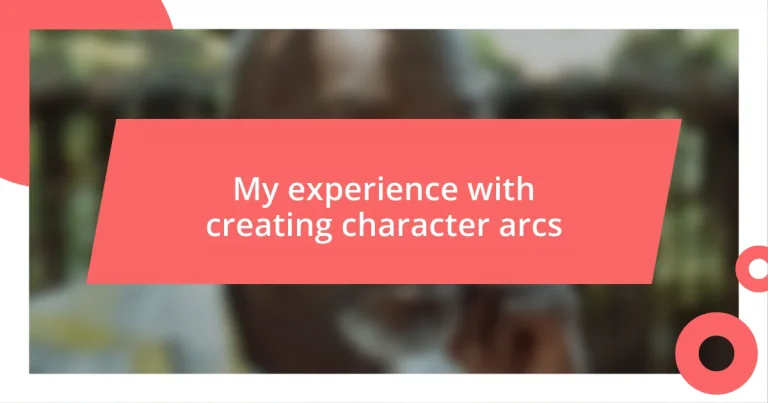Key takeaways:
- Character arcs consist of three stages: the initial state, transformation, and resolution, reflecting both characters’ and authors’ personal growth.
- Understanding character motivations—like the difference between what they desire and what they need—is essential for crafting authentic narratives.
- Balancing a character’s flaws and strengths enriches their journey and mirrors real-life self-discovery, while evaluating their development impacts reader engagement and emotional investment.
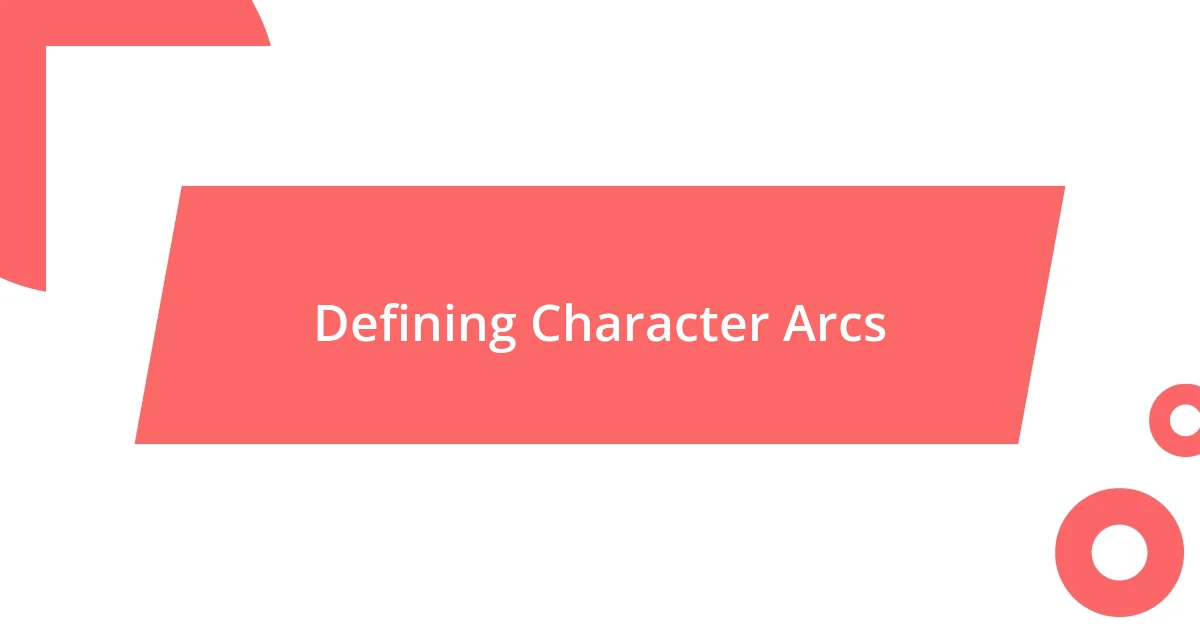
Defining Character Arcs
Character arcs are the transformative journeys that characters undergo throughout a story. I remember when I first learned about them; it felt like a lightbulb moment, realizing how crucial they are to making characters relatable and engaging. Have you ever felt disconnected from a character? I know I have, until I started focusing on their arcs.
A well-defined character arc often involves three key stages: the initial state, the transformation process, and the resolution. As I crafted my own characters, I found that their development mirrored my own experiences—insecure at the beginning but evolving through challenges. Isn’t it fascinating how our personal growth can reflect in the stories we tell?
When I think about characters with compelling arcs, I can’t help but recall the shift in motivations that makes them feel alive. For instance, one of my protagonists began as selfish, driven only by ambition. But through a series of trials, he started valuing relationships, revealing the depth of his humanity. Have you ever seen a character surprise you in this way? That’s the magic of a well-crafted character arc—it resonates not just in fiction, but in our own lives too.
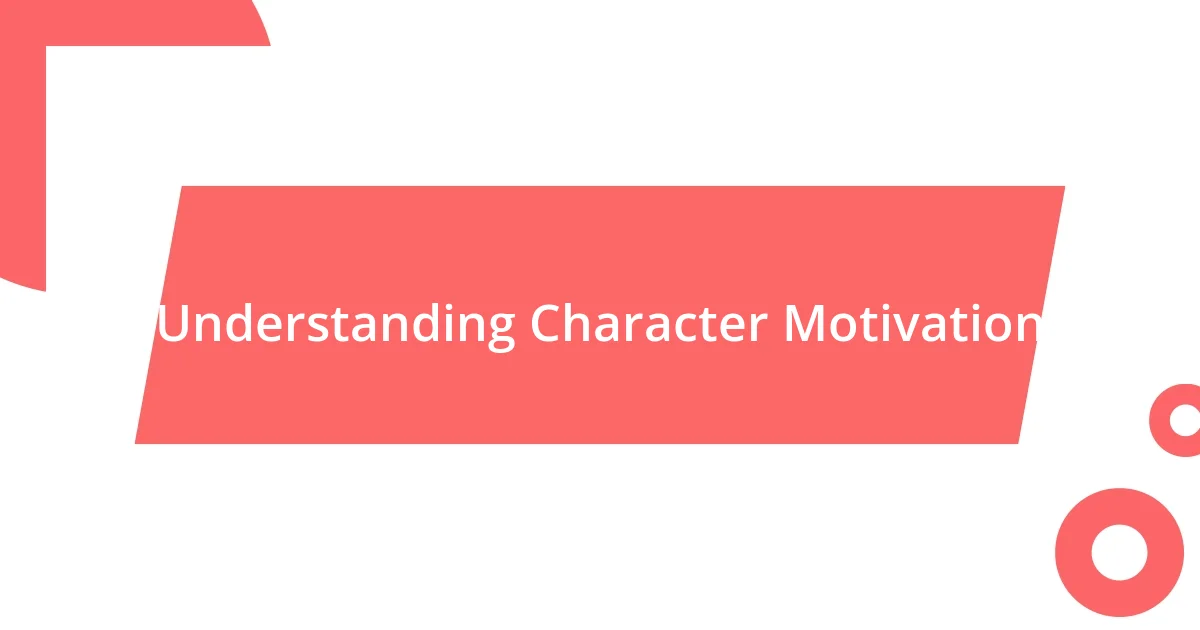
Understanding Character Motivation
Understanding what drives a character is so important in crafting a narrative that resonates. I often find myself diving deep into their backgrounds, exploring the events that shaped them. For example, I once created a character who was fiercely independent because of a childhood spent in foster care. This backstory didn’t just color her actions; it shaped her very motivations. When you understand what a character desires, you don’t just write decisions; you write a journey that feels authentic to the reader.
Here are some key points to consider about character motivation:
- Desire vs. Need: Often, what characters want is different from what they truly need. For instance, my character craved freedom but needed connection to heal her emotional wounds.
- Past Experiences: These are foundational. They inform a character’s choices and interactions.
- Conflict and Stakes: Motivations shine in the face of challenges. Watching my character navigate relationships while wrestling with trust issues added layers to her story.
- Evolution Over Time: Motivations can shift. As characters confront their fears, I noticed how their goals would adapt, reflecting their growth.
- External Influences: Sometimes, a character’s motivation is influenced by other people in their lives, adding depth to their arc.
By focusing on these aspects, I’ve seen my characters evolve into complex people with real struggles, making them relatable and memorable.
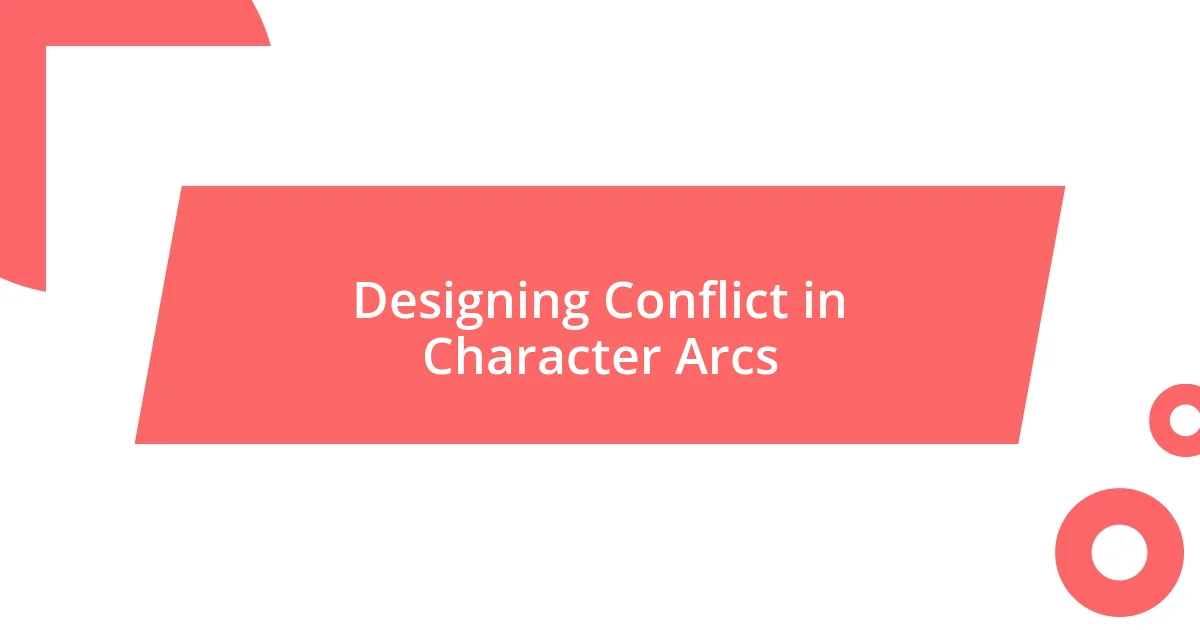
Designing Conflict in Character Arcs
Designing conflict within character arcs is like weaving a tapestry of tensions and resolutions that define a character’s journey. I distinctly remember creating a character who faced the constant battle between loyalty to family and her yearning for independence. This internal conflict created a tension that made readers root for her, as she navigated the storm of her emotions. Have you ever felt torn between two powerful desires? That’s the kind of relatable dilemma that fuels an engaging character arc.
On a broader scale, it’s critical to understand the types of conflict—both internal and external—that will shape your character. Internal conflict, such as self-doubt or guilt, gives depth to a character’s psyche. I once wrote about a character who wrestled with guilt after a tragic accident, and this inner turmoil colored every decision she made, allowing readers to connect with her pain. Meanwhile, external conflict, like societal challenges or antagonists, often propels the character forward. It’s amazing how these layers of conflict create a rich, dynamic character journey.
To illustrate the impact of conflict on character development, consider the following table that highlights these key aspects:
| Type of Conflict | Description |
|---|---|
| Internal Conflict | Struggles within the character, often related to emotions or beliefs. |
| External Conflict | Challenges posed by outside forces, such as other characters or societal pressures. |
| Resolution Style | How the character ultimately resolves their conflicts, defining their transformation. |
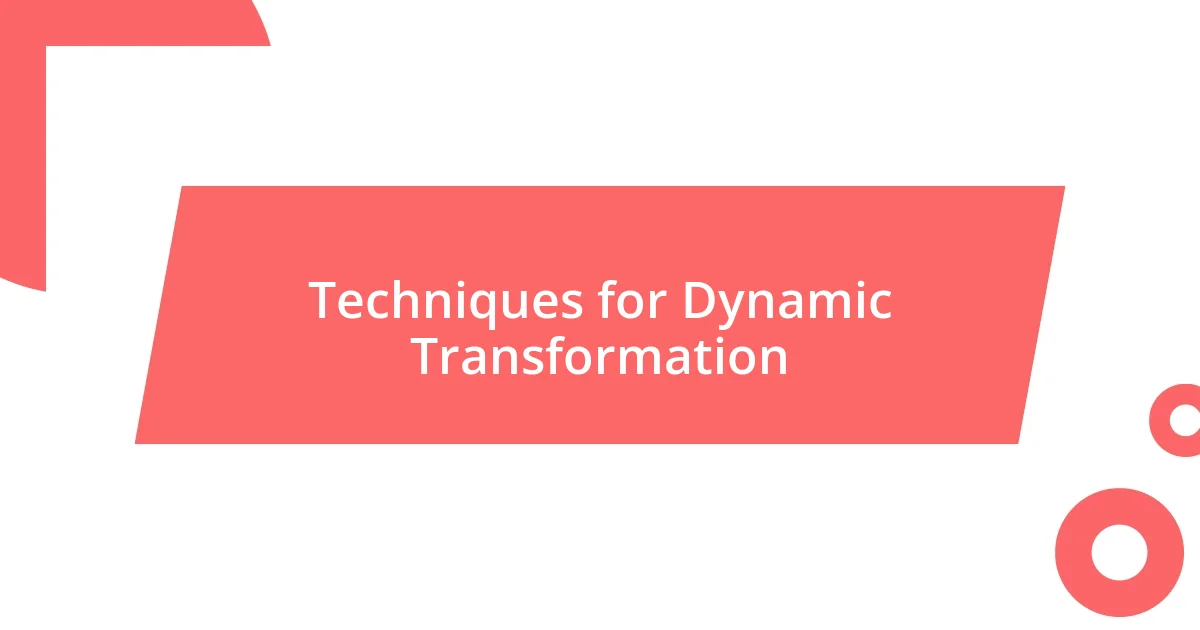
Techniques for Dynamic Transformation
Transforming a character involves careful consideration of their pivotal moments. One technique I love is pushing characters into challenging situations that force them to confront their deepest fears. There’s a moment I vividly recall when I put my character in a situation where she had to face her worst failure head-on. That moment not only catalyzed her transformation but also showcased how vulnerability can catalyze growth. Isn’t it fascinating how exposure to fear can lead to profound change?
Another effective technique is the use of mentors or pivotal secondary characters. I once introduced a wise old neighbor into my story who subtly nudged the protagonist toward self-reflection. Through their interactions, I noticed that the character began to understand her own limitations and strengths more clearly. This dynamic highlighted the importance of relationships in a character’s transformation. Have you ever had someone in your life who helped you see things differently? It’s a powerful element that enriches character arcs.
Lastly, introducing moral dilemmas is a fantastic way to showcase dynamic transformation. I remember crafting a scene where my character had to choose between saving a friend or her career. This heart-wrenching choice revealed layers of her personality that were previously hidden. It’s amazing how decisions in critical moments can redefine who a character is. How do we make choices that align with our true selves? This is the essence of dynamic transformation; it’s where the magic truly happens.
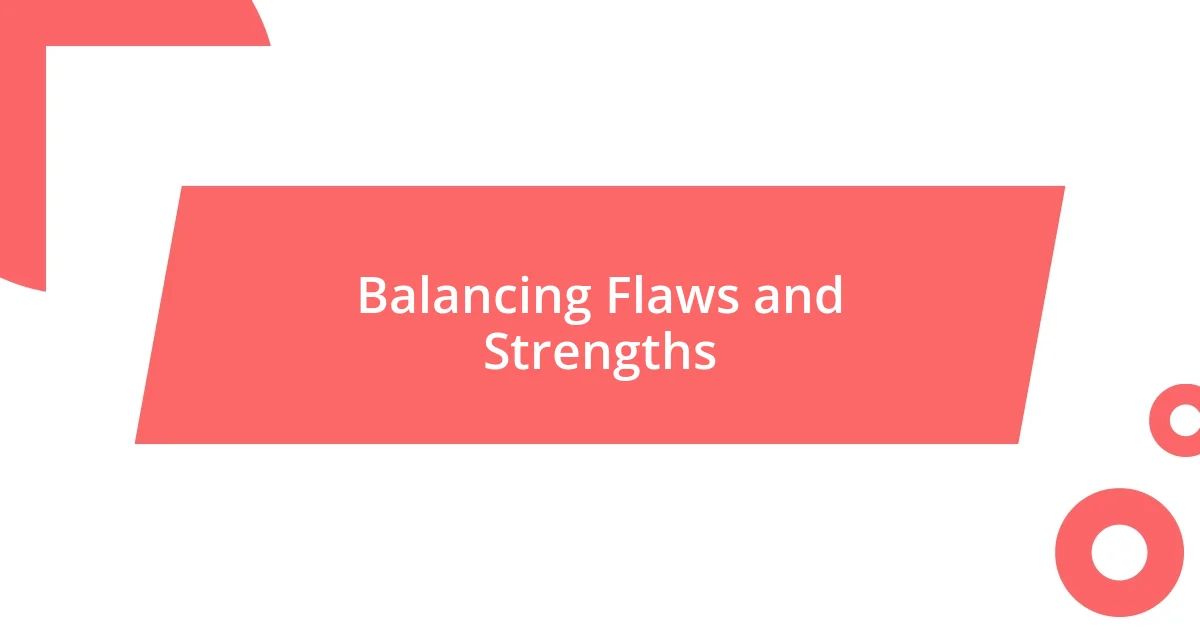
Balancing Flaws and Strengths
Balancing flaws and strengths in character arcs is a delicate act. I’ve found that presenting a character’s weaknesses alongside their strengths makes them feel more authentic and relatable. Take, for instance, a character I crafted who was fiercely ambitious but also had a tragic habit of pushing people away. This duality kept readers invested in her journey, as they could see both her brilliance and her struggles.
When I write, I often ponder how a character’s flaws can serve as a vehicle for growth. For example, during my writing process, one character confronted her tendency to overanalyze every situation, which not only stalled her progress but also alienated her friends. As she slowly learned to trust her instincts, it was remarkable to witness her transformation from a paralyzed thinker into a decisive doer. How many of us have felt stuck, caught between the desire to do what’s right and the fear of making the wrong choice?
In that vein, I believe flaws do not just hinder characters; they catalyze development. I once designed a story around a character who struggled with jealousy, particularly towards a close friend’s success. Watching him grapple with this flaw was intense. It pushed him to reassess his self-worth and ultimately led to a deeper understanding of friendship and collaboration. Isn’t it intriguing how a flaw can illuminate strengths we never knew we had? Balancing flaws and strengths not only enriches character arcs but also mirrors our own journeys toward self-discovery.
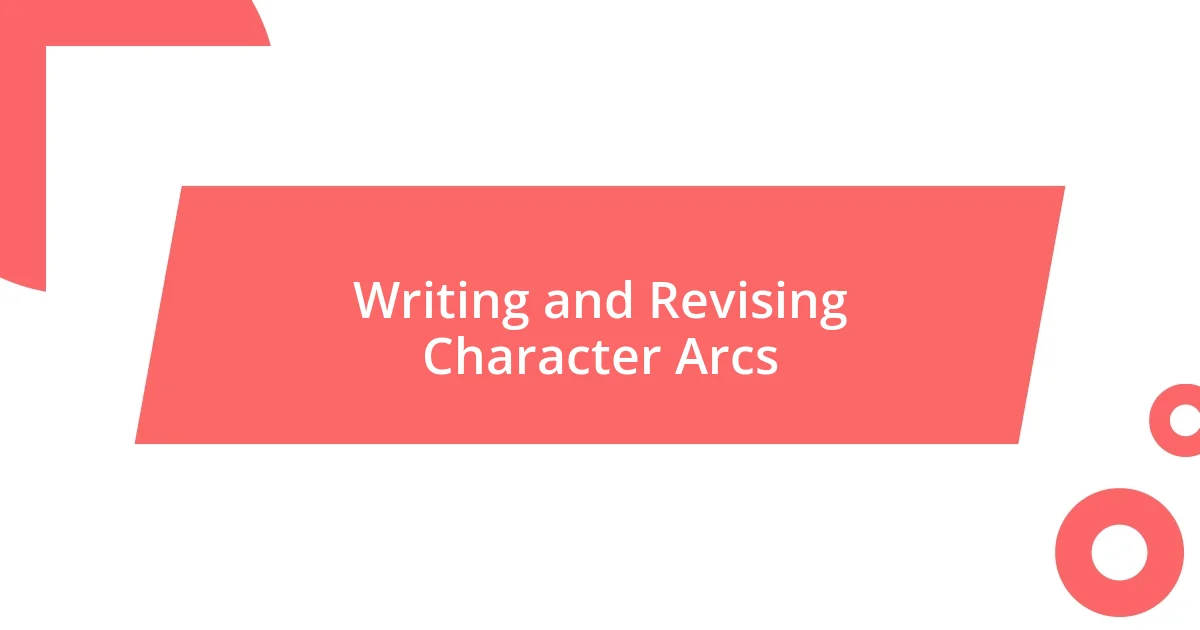
Writing and Revising Character Arcs
Writing and revising character arcs requires a deep dive into each character’s evolution. I remember meticulously mapping out my character’s journey on a whiteboard, connecting pivotal moments with emotional highs and lows. This visual representation made it easier for me to spot inconsistencies and identify where the character’s growth felt authentic—or forced. It’s almost like creating a roadmap: if the path feels illogical or zigzags too much, it’s time to hit ‘revise’.
During my revisions, I often ask myself how each scene contributes to revealing the character’s motivations. For one character, a seemingly insignificant exchange with a waitress shifted my perspective; it was in that moment he realized he couldn’t escape his past by merely running from it. This tiny interaction became a turning point, illuminating a facet of his personality that I hadn’t fully explored before. Isn’t it incredible how small details can lead to substantial character development?
Occasionally, I’ll find myself grappling with the overall direction of a character’s arc. I once had a protagonist who started as overly naive but then spun into arrogance, which felt unnatural. After some serious soul-searching, I decided to weave in a subplot where she faces the consequences of her arrogance. This not only grounded her journey but also gave me a chance to reflect on how our missteps shape us. How often do we have to fail before we truly learn? The essence of crafting character arcs lies in that ongoing dance between triumph and failure, guiding them toward their true selves.
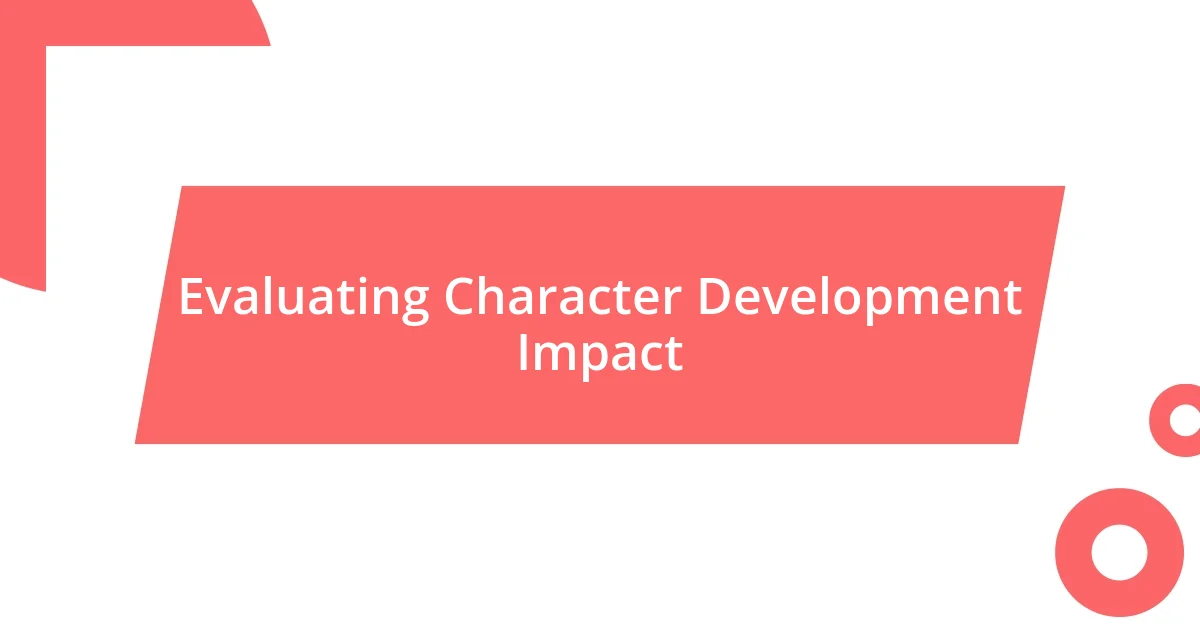
Evaluating Character Development Impact
Character development is crucial in engaging readers, as it directly affects their emotional investment in the story. I remember watching my audience react differently to a character who started as a villain but gradually revealed deeper layers of vulnerability. This transformation left readers questioning their initial judgments, demonstrating how well-executed arcs can shift perspectives and create empathy. Isn’t it fascinating how a character’s evolution can mirror our own complexities in real life?
When evaluating the impact of character development, I often reflect on character moments that shape their identity. One memorable instance was a story where a mentor figure’s betrayal propelled the protagonist into a self-discovery journey. I found that this pivotal event not only shaped the protagonist’s decisions but also resonated with readers who might have experienced similar betrayals. It made me realize that effective arcs often tap into universal emotions—reminding us that we are not alone in our struggles.
Furthermore, I’ve observed that characters’ choices heavily influence the stakes of the plot. In one narrative, a character had to choose between ambition and loyalty. Her decision to prioritize friendship over personal gain not only propelled the story forward but also sparked deeper discussions among my readers about values and priorities. Isn’t it incredible how a simple choice can trigger a reflection of our own dilemmas? Evaluating character development isn’t just about tracking growth; it’s about recognizing the impact of choices that resonate long after the story ends.












